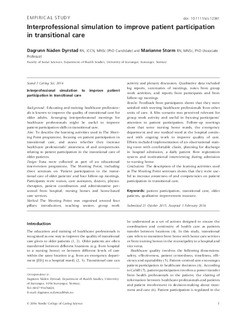Interprofessional simulation to improve patient participation in transitional care
Journal article, Peer reviewed
Accepted version
Permanent lenke
http://hdl.handle.net/11250/2468257Utgivelsesdato
2016-07Metadata
Vis full innførselSamlinger
Originalversjon
Dyrstad, D.N.; Storm, M. (2016) Interprofessional simulation to improve patient participation in transitional care. Scandinavian Journal of Caring Sciences, 31(2), pp. 273-284 10.1111/scs.12341Sammendrag
Background: Educating and training healthcare professionals is known to improve the quality of transitional care for older adults. Arranging interprofessional meetings for healthcare professionals might be useful to improve patient participation skills in transitional care.
Aim: To describe the learning activities used in The Meeting Point programme, focusing on patient participation in transitional care, and assess whether they increase healthcare professionals’ awareness of and competencies relating to patient participation in the transitional care of older patients.
Design: Data were collected as part of an educational intervention programme, The Meeting Point, including three seminars on ‘Patient participation in the transitional care of older patients’ and four follow-up meetings. Participants were nurses, care assistants, doctors, physiotherapists, patient coordinators and administrative personnel from hospital, nursing homes and home-based care services.
Method: The Meeting Point was organised around four pillars: introduction, teaching session, group work activity and plenary discussion. Qualitative data included log reports, summaries of meetings, notes from group work activities, and reports from participants and from follow-up meetings.
Results: Feedback from participants shows that they were satisfied with meeting healthcare professionals from other units of care. A film scenario was perceived relevant for group work activity and useful in focusing participants’ attention to patient participation. Follow-up meetings show that some nursing home wards, the emergency department and one medical ward at the hospital continued with ongoing work to improve quality of care. Efforts included implementation of an observational waiting room with comfortable chairs, planning for discharge in hospital admission, a daily patient flow registration system and motivational interviewing during admission to nursing home. Conclusions: The description of the learning activities used at The Meeting Point seminars shows that they were useful to increase awareness of and competencies on patient participation in transitional care.
Beskrivelse
This is an accepted version of the article. The original is available at http://onlinelibrary.wiley.com/doi/10.1111/scs.12341/abstract;jsessionid=1AF42118605EDBD498F7DFCF4900C430.f03t01.
